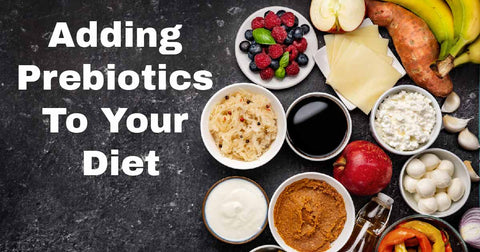In recent years, scientific attention has turned towards understanding the relationship between the human gut and its resident microbial communities. Within this context, prebiotics have emerged as essential components contributing to the maintenance of a balanced and healthy digestive system.
Prebiotics, classified as non-digestible fibers, play a crucial role in providing nourishment to the beneficial bacteria naturally present in the gastrointestinal tract. Distinct from probiotics, which involve the introduction of live microorganisms into the body, prebiotics act as substrates, selectively stimulating the growth and activity of indigenous microbes.
These dietary components are naturally found in various foods, including fruits, vegetables, legumes, and whole grains. The incorporation of prebiotic-rich foods into daily meals not only supports the diversity of the gut microbiome but also promotes an environment conducive to optimal gut health. In this article on prebiotics, we will look into their definition, their significance in the gut microbiome, and practical ways to integrate them into our diets for sustained digestive well-being.
Understanding Prebiotics

Prebiotics belong to a category of dietary fibers that withstand digestion in the upper gastrointestinal tract, reaching the colon intact. The human body lacks the enzymes necessary to break down these compounds, allowing them to serve as a fundamental fuel source for the beneficial bacteria residing in the gut. These indigestible fibers essentially act as nourishment, fostering the growth and activity of specific beneficial bacterial strains crucial for gut health.
Prebiotics distinguish themselves from probiotics in their mode of action. While probiotics involve the direct introduction of live bacteria into the body, prebiotics function differently. Rather than adding new microbial species, prebiotics stimulate the growth and metabolic activity of the already existing beneficial bacteria. By doing so, they enhance the resilience and functionality of the gut microbiome.
The gut microbiome is an ecosystem housing countless microorganisms. This diverse community, primarily located within the digestive system, includes various bacterial species that play vital roles in metabolism, immune function, and overall well-being. Prebiotics, by supporting the growth of beneficial bacteria such as bifidobacteria and lactobacilli, contribute significantly to maintaining a balance within this complex microbial community.
Prebiotics act as the architects of a thriving gut environment, providing the necessary sustenance for the existing beneficial bacteria and playing a crucial role in fostering a balanced and resilient gut microbiome.
Types of Prebiotic Foods
Prebiotic-rich foods offer a diverse range of options, ensuring a flexible yet consistent intake of these beneficial fibers in everyday diets. Among the standout sources, certain fruits possess notable prebiotic content. Bananas, recognized for their abundance of resistant starch—a type of starch that resists digestion in the small intestine—stand as a prominent prebiotic contributor. Additionally, berries, particularly raspberries and blackberries, boast substantial amounts of soluble fiber, further augmenting their prebiotic properties.
Vegetables represent another crucial category of prebiotic-rich foods. Garlic, onions, leeks, and asparagus emerge as notable sources owing to their high inulin content. Inulin, a type of dietary fiber, serves as a fuel source for beneficial gut bacteria, promoting their growth and activity within the digestive system.
Furthermore, whole grains play a significant role in augmenting prebiotic intake. Varieties like oats and barley offer notable contributions through compounds like beta-glucans and arabinoxylans. These components not only fortify the fiber content of these grains but also diversify the spectrum of prebiotics in one's diet, supporting the cultivation of a healthy gut microbiome.
Significance of Diversity
The importance of a diverse prebiotic intake lies in the nutritional richness offered to the gut microbiome. Each prebiotic source carries its unique set of fibers and compounds, fostering the growth of specific beneficial bacteria. Incorporating a variety of prebiotic-rich foods into the diet presents a buffet of nutrients for the diverse microbial community residing in the gut. This varied menu supports not only the proliferation of a broader spectrum of beneficial bacteria but also a more resilient gut environment.
Creating Resilience in the Gut Microbiome
The consumption of a wide range of prebiotic foods offers a holistic approach to gut health. By exposing the gut microbiome to diverse prebiotic substrates, we create an environment where various beneficial bacteria can thrive. This diversity acts as a safeguard, bolstering the resilience of the gut microbiome against potential disruptions, and aiding in the maintenance of a balanced and thriving gut ecosystem.
Tips for Incorporating Prebiotics

Diversify Whole Grains
Expanding your whole grain repertoire beyond the usual staples can significantly boost prebiotic intake. Incorporate grains like barley, quinoa, and buckwheat into your meals to capitalize on their prebiotic fiber content. These grains not only offer nutritional benefits but also serve as versatile substitutes for refined grains in various recipes, enhancing the overall dietary fiber content.
Embrace Legumes Regularly
Including legumes as a staple in your diet is a strategic approach to increase prebiotic fiber intake. Lentils, chickpeas, and various beans are powerhouse sources of prebiotics. Experiment with incorporating these legumes into a diverse array of dishes such as soups, stews, salads, or simply as flavorful sides. Their versatility allows for easy integration into daily meals while promoting gut health.
Experiment with Resistant Starches
Exploring foods rich in resistant starch presents another avenue to support your gut's beneficial bacteria. Incorporate cooked and cooled potatoes, green bananas, or legumes like black beans into your diet. These resistant starches act as prebiotics when they reach the colon, offering sustained nourishment to the gut microbiota and contributing to a balanced digestive ecosystem.
Meal Planning and Grocery Shopping
- Explore Farmer's Markets and Local Produce
Exploring local farmer's markets or opting for locally sourced produce broadens access to an array of fresh, seasonal fruits, and vegetables. This exposure introduces opportunities to experiment with a wider variety of prebiotic-rich options, encouraging diversity in your dietary intake.
- Batch Cooking with Prebiotic Ingredients
Streamlining meal preparation by batch cooking with prebiotic ingredients simplifies the incorporation of these beneficial components into your routine. Prepare large batches of meals incorporating diverse prebiotic elements such as soups, casseroles, or grain bowls. Storing these meals for future consumption ensures a consistent intake of prebiotics even on busy days.
- Seek Prebiotic Recipe Inspiration
Exploring resources like cookbooks, food blogs, or dedicated culinary websites focusing on prebiotic-rich recipes can inspire creativity in meal planning. Experimenting with new recipes not only introduces enjoyable ways to integrate prebiotics but also adds variety and excitement to your culinary repertoire.
Recipes Rich in Prebiotics

Breakfast Recipes
- Overnight Oats with Mixed Berries and Chia Seeds
Blend oats, almond milk, chia seeds, and a touch of honey in a jar. Layer it with a medley of prebiotic-rich berries such as raspberries, blueberries, and sliced bananas. Let it refrigerate overnight for a convenient, prebiotic-packed breakfast that offers a healthy start to your day.
- Avocado Toast with Sautéed Spinach and Garlic
Prepare a hearty breakfast by toasting whole-grain bread, spreading mashed avocado, and topping it with a flavorful mix of sautéed spinach and garlic. This nutrient-dense option provides a savory kick to your morning routine, infused with prebiotic goodness.
Lunch and Dinner Ideas
- Quinoa and Roasted Vegetable Buddha Bowl
Create a satisfying meal by roasting a colorful array of prebiotic-rich vegetables, including sweet potatoes, bell peppers, and broccoli. Serve them atop a bed of quinoa and complement the bowl with a zesty tahini-lemon dressing, offering a delightful combination of flavors and nutrients.
- Chickpea and Kale Curry over Brown Rice
Simmer chickpeas and kale in a fragrant curry sauce infused with coconut milk, turmeric, and ginger. Serve this aromatic curry over brown rice for a flavorsome and prebiotic-packed dinner option that is both comforting and nutritious.
Snack Options

- Hummus with Colorful Veggie Sticks
Pair homemade or store-bought hummus with an assortment of colorful vegetable sticks such as carrots, bell peppers, and cucumbers. This crunchy and flavorful snack provides a satisfying crunch while offering a dose of prebiotics.
- Fruit and Yogurt Parfait with Granola
Layer plain Greek yogurt with prebiotic fruits like sliced kiwi, mango, and strawberries in a glass. Top it off with a sprinkle of granola or nuts for added texture and nutrients, creating a delicious and nutritious snack or dessert option.
Prebiotics for Specific Dietary Needs
People adhering to vegetarian or vegan diets can incorporate prebiotics through plant-based sources abundant in these dietary fibers. Legumes like chickpeas, lentils, and various beans are excellent prebiotic sources. Whole grains such as quinoa and barley, alongside an array of fruits, vegetables, and nuts/seeds, offer diverse options to enhance prebiotic intake within a plant-based diet. Meals combining these elements not only fulfill nutritional needs but also support a flourishing gut microbiome.
Dietary Restrictions
In gluten-intolerant people, a prebiotic-rich diet is still achievable through gluten-free alternatives. Staples like quinoa and brown rice serve as valuable sources of prebiotics. Additionally, an assortment of fruits, vegetables, and gluten-free oats can be incorporated to ensure a well-rounded, prebiotic-friendly diet. Exploring diverse ingredients and opting for gluten-free options not only addresses dietary restrictions but also fosters gut health through these essential fibers.
Understanding dietary needs and limitations while navigating prebiotic-rich food choices empowers individuals to create diverse, flavorful, and nutritionally adequate meals. Including these elements into specific diets ensures the benefits of prebiotics for gut health are accessible to all.
Potential Challenges and Solutions
 Incorporating prebiotics into one's diet can pose challenges, particularly for individuals unaccustomed to high-fiber intake. Common issues include digestive discomfort such as bloating or gas, especially during the initial stages of incorporating prebiotic-rich foods.
Incorporating prebiotics into one's diet can pose challenges, particularly for individuals unaccustomed to high-fiber intake. Common issues include digestive discomfort such as bloating or gas, especially during the initial stages of incorporating prebiotic-rich foods.
Strategies for Overcoming Challenges
- Gradual Increase in Intake: Incrementally introducing prebiotic sources allows the gut to acclimate to higher fiber content. This gradual adjustment minimizes the likelihood of experiencing discomfort.
- Adapt Cooking Methods: Certain cooking techniques, like steaming or sautéing, can make vegetables more digestible. For instance, lightly cooking cruciferous vegetables such as broccoli or cauliflower can reduce their potential to cause gas.
- Hydration: Ensuring adequate hydration is essential when increasing fiber intake. Ample water intake supports the movement of fiber through the digestive system, aiding in smoother digestion.
- Professional Guidance: Seeking advice from a healthcare professional or a registered dietitian can offer personalized recommendations. They can provide tailored strategies to manage and overcome any digestive discomfort associated with incorporating prebiotics.
Conclusion
Nurturing our gut health stands as a cornerstone, and prebiotics serve as an invaluable ally in this endeavor. Understanding the role of these non-digestible fibers in fostering a thriving gut microbiome illuminates the path to a healthier lifestyle.
Embracing prebiotics isn't just a dietary choice; it's a step towards supporting digestive health, bolstering immunity, and potentially enhancing overall wellness. With thoughtful consideration and gradual incorporation, reaping the benefits of a prebiotic-rich diet becomes an accessible and rewarding journey. Before you proceed to add these prebiotic-rich diets to your food, you first need to identify whether your body can tolerate these foods. You can do so using Advanced Food Intolerance Labs (AFIL)’ s at-home test kits that can help you identify all the foods that your body cannot tolerate.
Watch AFIL test kits testimonial videos click here
References:
- Douglas, Linda C., and Mary E. Sanders. "Probiotics and prebiotics in dietetics practice." Journal of the American dietetic association 108.3 (2008): 510-521.
- Lockyer, S., and S. Stanner. "Prebiotics–an added benefit of some fibre types." Nutrition Bulletin 44.1 (2019): 74-91.
- Rodgers, Svetlana. "Value adding with functional meals." Food Service Technology 4.4 (2004): 149-158.
- Lang, Jenna M., Jonathan A. Eisen, and Angela M. Zivkovic. "The microbes we eat: abundance and taxonomy of microbes consumed in a day’s worth of meals for three diet types." PeerJ 2 (2014): e659.
- Iacovou, Marina, et al. "The low FODMAP diet and its application in East and Southeast Asia." Journal of neurogastroenterology and motility 21.4 (2015): 459


.png?v=1737390083)
.png?v=1737187409)


